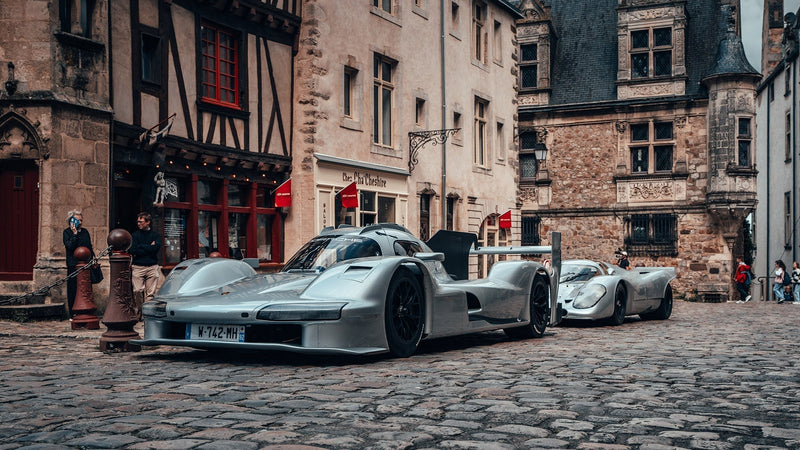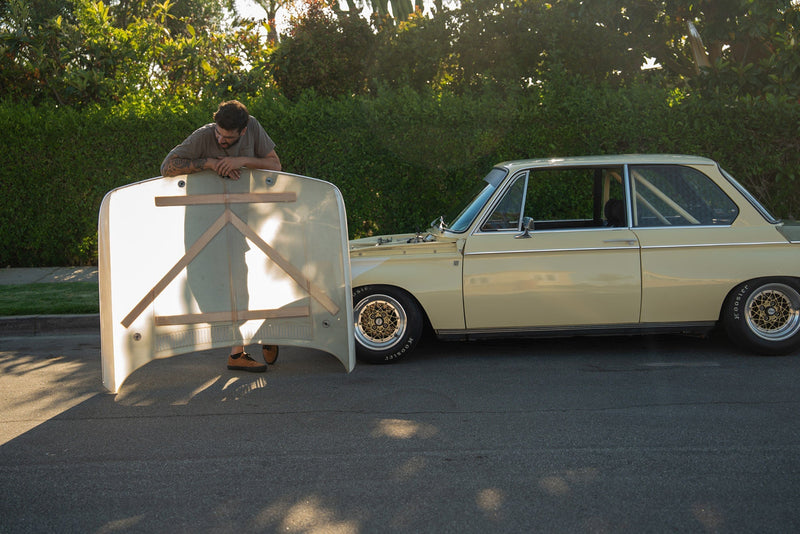After spending a great deal of time pressing buttons on my cameras, there are certain moments that make me realize my good luck. You can argue that without a story or an emotion at the core of the subject, good gear and good light produce little more than meaningless prettiness. I am fortunate and grateful, for in Sicily there is no shortage of stories worth telling (to be done so in so many mediums; words, photos, food, a simple hug hello).
This one takes us back to a hot day in June. I had just returned home from the Vernasca Silver Flag, and after a hectic weekend at the track trying to capture everything, the only activity I had in mind was a swim in the sea. Hand on the doorknob, the telephone bleats from the other room and drags me back inside. The voice on the other end belongs to a good friend, a true gentleman with exceptional taste in vehicles. I change out of my swim trunks in a hurry, get dressed and pack my camera bag nearly simultaneously, and am rushing out the door with a new destination in mind.




We meet in the sunny countryside of Partanna, in the south of Trapani. Surrounded by vineyards and rows of olive trees under the baking summer sun, this town has the interesting claim as the having the greatest number of registered tractors in Sicily. We’re here to celebrate a machine that’s more exotic than some trundling farm equipment, though.
The ISO Rivolta is like a Riva on wheels, a muscle car in a European suit. It’s not a small car yet it’s still quite lithe. It’s not well known outside of car enthusiast circles, yet it captures pedestrian attention at nearly Ferrari 250 levels. Beautiful, comfortable, and packing a big Chevy V8 to get raucous with, the ISO Rivolta is an exceptional piece of engineering and design.
The story of the car can stretch back to the pre-war period if you connect enough dots of the Iso story, but the sports cars are surely couched in ISO’s post-war iteration. In the late 1940s, company head Renzo Rivolta was living in an Italy that was all but destroyed by the second world war, and decided to do what a lot of industrialists did in those days: build affordable, practical transportation solutions. This led to scooters, small-displacement motorcycles, and other forms of compact and cheap means of travel, like the Isetta bubble car from the 1950s, which used a repurposed a refrigerator door (Rivolta briefly ran a refrigeration outfit before the war).



With the Isetta in the early 1950s, Renzo Rivolta started to pivot from two-wheeled transport to four-wheeled, and soon enough he was making plans for performance cars. The European economies were making such frivolous things as sports cars palatable, and by the early 1960s Rivolta had assembled a team to produce the first Iso performance car, the IR 300. Giorgetto Giugiaro would style it, and Rivolta, Giotto Bizzarrini, and Pierluigi Raggi would take on the brunt of engineering duties.
The effort from this A-Team of Italians was paired with a American heart—a Chevy-sourced 5350cc V8—and thus the first ISO GT car was born. The IR 300 was an accomplished design and a great example of the European-American pairings of the time, and though the engine choice saved on the costs of designing and building a new one from scratch, there was little about the ISO Rivolta IR 300 that could be considered cheap (like inboard rear brakes). The factory and the machinery inside that built the cars were massive expenses in their own right, and part of the reason that Rivolta got into auto manufacturing in the first place was to rectify what he perceived as a lack of quality in the sports cars he’d owned in the past. It’s reported that between the variants altogether, only 799 were built. Of course, Iso made other cars concurrently and after the end of the GT/IR, but the company ceased production altogether (in 1974) not long after it got started, making any ISO on the road a rarity.





This IR 300 is number 114 of the 799 GTs built, with an extraordinary story of conservation behind it. Purchased and registered in Milan in 1964 by the original owner, Rodolfo Baroni (a manager at Jaguar CGA), the car retains its original condition today thanks to the skilled hands of Mario Romeo, the current owner and one of the foremost experts of historic cars on Italian soil. An extremely sunny person, in love with life, his passions and his cars are nearly one in the same. He is addicted. An automotive encyclopedia. And in addition to being such an avid enthusiast, Mario’s also made his love into a business. In this charming town that he calls home, he owns and operates a specialty car dealership, and if you are even slightly interested in good cars (or just some good wine), I advise you to stop and have a chat with him should you ever find yourself in this section of Sicily. Time moves slower here, as they say, but in Mario’s company the hours still manage to fly.
After one of these “quick” chats (swapping stories, about Alfa Romeos and Porsches mainly, but you know how far the tangents can go…), Mario plucks the keys for the ISO out of his collection, and once he starts it up the noise pushes every other thought squarely out of mind. We creep out onto the street as the car warms up with a sound that can only be described as anti-stealth, and soon enough we are out of the cobblestones and in the countryside. Mario’s eyes seem to sparkle with each upshift (to say nothing of nicely rev-matched downshifts), and although the engine has enough output to put me firmly against the back of the seat, I’m struck by how supremely comfortable and almost supple the ride is. It feels like a 1960s Milanese lounge chair with a V8 attached.





We aren’t moving at a tremendous pace, but a wandering across a member of the Carabinieri would be cause enough for some brake pedal. The car doesn’t carve through a turn as much as it “occupies” one (it is not a small machine after all, and these roads are more Fiat than Iso proportioned). In other words, it is an excellent GT experience, and it happens to be wrapped up in this beautiful packaging.
So satisfying is the on-road demeanor of the ISO Rivolta that we almost forget to shoot. But before the sun completed its westward arc and sent us home with the headlights on, we found a small turn off to park in, with the day’s last rays weaving some golden light into the ruby red metallic. Sunset comes quickly though, and we climb back in to follow our winding route back home. The ISO may not have the same clout and provenance as the hero cars of its time, but it’s near peerless when taken as a whole. As far as “mutts” go—the Italian design and the American engine in this case—this one’s prettier than most purebreds, and while ISOs don’t come cheap, keeping the beast under hood happy doesn’t require the depth of pocket suggested by the presence of this car. Line it up next to anything, it’s just plain pretty.
The point is not beauty or to make comparisons, though; logic is often absent from decisions about Italian sports and GT cars anyway, right? The point of this story is that if the car you drive makes you smile like it does Mario, what more can you ask for?

























































